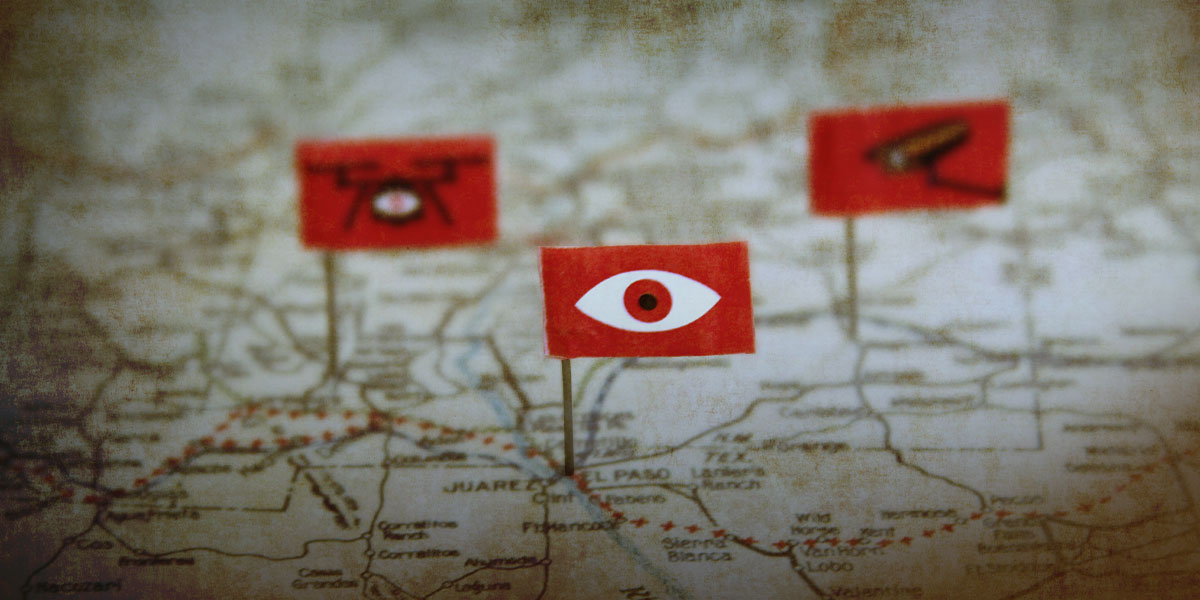UPDATE: We have launched our full Atlas of Surveillance project, covering the entire United States. Check it out at atlasofsurveillance.org
A Guide to the Police Technology Deployed in Counties Along the U.S.-Mexico Border
The Electronic Frontier Foundation has partnered up with the University of Nevada, Reno's Reynolds School of Journalism to begin an inventory of what surveillance technologies law enforcement agencies across the country have acquired. We started with communities along the U.S.-Mexico border: areas of contention and controversy, where discussions of “virtual walls” have resulted in increased funding and focus on surveillance.
Over the course of the spring and summer of 2019, Reynold School students scoured the internet for news articles, research reports, press releases, and public records to compile a set of more than 225 data points where surveillance technology is located in the 23 border-facing counties in California, Arizona, New Mexico, and Texas.
We found 36 local government agencies using automated license plate readers (ALPR), 45 outfitting officers with body-worn cameras, and 20 flying drones. Our research also maps a variety of technologies the federal government has deployed in these counties, from sensor towers to surveillance blimps.
In addition to building this data set, Reynolds School students wrote detailed profiles of six particular border counties: San Diego, California; Pima and Cochise counties, Arizona; Doña Ana County, New Mexico; and El Paso and Webb counties, Texas. The aim is to provide local residents with an easily accessible field guide to the surveillance technologies that law enforcement agencies have placed in their communities.
Highlights
Biometrics
January 10, 2020 update: Due to the passage of a California law banning mobile face recognition for three years, the San Diego area law enforcement agencies have all ended their face recognition programs and we have removed them from the dataset.
We found that 31 law enforcement agencies in San Diego County, California, access face recognition technology through a regional partnership, accounting for more than 25,000 queries in 2018 alone. Law enforcement in Texas and Arizona are able to make face recognition requests through their states’ respective departments of public safety. In Doña Ana County, New Mexico, the sheriff’s office pursued face recognition cameras that are mounted on protective eyewear. Doña Ana County deputies, along with their counterparts in Cameron, Hidalgo, and El Paso counties in Texas, are using iris scanners in their jails.
Operation Stonegarden
Local law enforcement agencies along the border often acquire surveillance technologies through Operation Stonegarden, a federal program that funds local police that participate in border security operations. The Laredo Police Department in Texas, and the Yuma County Sheriff’s Office and Marana Police Department in Arizona, have acquired automated license plate readers (ALPRs) through Operation Stonegarden. The Hidalgo County Sheriff’s Office, Hidalgo Police Department, Edinburg Police Department, and Pharr Police Department in Texas have used Stonegarden funds to purchase Skycop surveillance trailers, equipped with cameras and ALPRs. Meanwhile, the Webb County Sheriff’s department used Operation Stonegarden funds to install 10 surveillance camera towers along its border with Mexico.
CBP Surveillance
Our research maps out the county-by-county placement of a variety of surveillance systems operated by U.S. Customs and Border Protection and one of its units, the U.S. Border Patrol. The agencies operate tethered surveillance blimps called “aerostats,” some of which are permanently tethered and others that can be relocated based on need. There are also a variety of surveillance towers throughout the region, often equipped with cameras, radars, and infrared sensors. In addition, the agencies deploy ground sensors, ALPRs, and drones. We also found that the U.S. Drug Enforcement Administration operates ALPRs in the border region.



